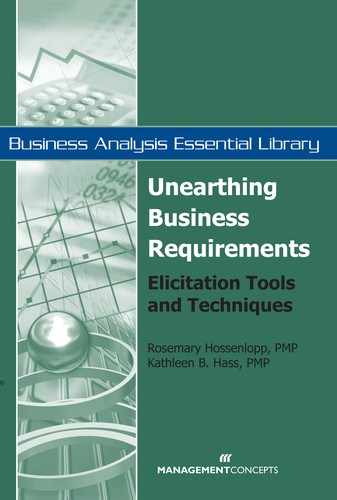Summary
![]() Effective requirements are the best defense against requirements risks to projects. Since defective requirements contribute significantly to project cost and schedule overruns, professional business analysts are focusing heavily on requirements planning and elicitation. Use another volume in this series, Getting It Right: Business Requirement Analysis Tools and Techniques, to hone your requirements analysis, specification, documentation, and validation skills.
Effective requirements are the best defense against requirements risks to projects. Since defective requirements contribute significantly to project cost and schedule overruns, professional business analysts are focusing heavily on requirements planning and elicitation. Use another volume in this series, Getting It Right: Business Requirement Analysis Tools and Techniques, to hone your requirements analysis, specification, documentation, and validation skills.
![]() The key elicitation activities are brainstorming, discovery sessions, interviews, surveys, documentation reviews, interface analysis, and supplemental requirements analysis.
The key elicitation activities are brainstorming, discovery sessions, interviews, surveys, documentation reviews, interface analysis, and supplemental requirements analysis.
![]() Brainstorming is the process of generating ideas and then gaining consensus on which ideas to go forward with for additional action. Its strength is that it produces creative results, and its weakness is that it introduces assumptions too early.
Brainstorming is the process of generating ideas and then gaining consensus on which ideas to go forward with for additional action. Its strength is that it produces creative results, and its weakness is that it introduces assumptions too early.
![]() Workshop and discovery sessions are formal meetings with multiple stakeholders. The purpose of the meetings is documenting requirements.
Workshop and discovery sessions are formal meetings with multiple stakeholders. The purpose of the meetings is documenting requirements.
![]() Interviewing is a systematic process of collecting information from sponsors, customers, and users. A formal script enables consistent interpretation of results.
Interviewing is a systematic process of collecting information from sponsors, customers, and users. A formal script enables consistent interpretation of results.
![]() Surveys are the administration of a written set of questions to the stakeholders. Surveys reduce the time commitment required from the stakeholder groups. Incentives are often required to improve the low response rate.
Surveys are the administration of a written set of questions to the stakeholders. Surveys reduce the time commitment required from the stakeholder groups. Incentives are often required to improve the low response rate.
![]() Documentation reviews are accomplished by reviewing existing system, business policy, and contractual documentation to quickly gain familiarity with the current environment. However, the documentation may be outdated and may not actually reflect the current practices or system.
Documentation reviews are accomplished by reviewing existing system, business policy, and contractual documentation to quickly gain familiarity with the current environment. However, the documentation may be outdated and may not actually reflect the current practices or system.
![]() Analyzing interfaces means reviewing the system, people, and process linkages. Use of this technique can uncover missed interfaces or users.
Analyzing interfaces means reviewing the system, people, and process linkages. Use of this technique can uncover missed interfaces or users.
![]() Documenting supplemental requirements is a review of the users’ expectations of system behavior that may constrain the development of the solution. The process of documenting supplemental requirements also uncovers missed business, user, or supplemental requirements and often requires some prototyping for effective communication with the users.
Documenting supplemental requirements is a review of the users’ expectations of system behavior that may constrain the development of the solution. The process of documenting supplemental requirements also uncovers missed business, user, or supplemental requirements and often requires some prototyping for effective communication with the users.
Action Plan for the Business Analyst
![]() Review the common techniques that you use on your current projects.
Review the common techniques that you use on your current projects.
![]() Use additional techniques that are appropriate to project size, complexity, and risk.
Use additional techniques that are appropriate to project size, complexity, and risk.
![]() Utilize a survey to understand how satisfied users are with elicitation results.
Utilize a survey to understand how satisfied users are with elicitation results.
![]() Compose an interview to ask the project sponsor his or her opinion of the role of the business analyst.
Compose an interview to ask the project sponsor his or her opinion of the role of the business analyst.
![]() Include the solution development team in the process of deciding which elicitation techniques should be used on your next project.
Include the solution development team in the process of deciding which elicitation techniques should be used on your next project.
